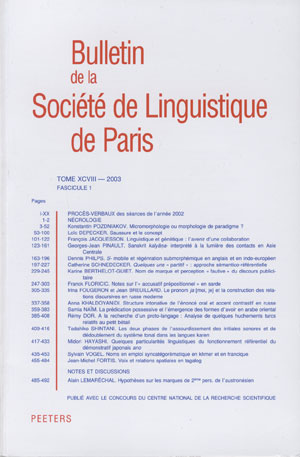 previous article in this issue previous article in this issue | next article in this issue  |

Preview first page |
Document Details : Title: Simplicité de la flexion mordve? Author(s): LÉONARD, Jean-Léo Journal: Bulletin de la Société de Linguistique de Paris Volume: 103 Issue: 1 Date: 2008 Pages: 363-400 DOI: 10.2143/BSL.103.1.2033495 Abstract : Les langues mordves, erzya et mokša, sont réputées parmi les spécialistes de langues ouraliennes pour la complexité de leurs paradigmes flexionnels, notamment la conjugaison objective définie. Le présent article tente de montrer qu’il est possible de réduire la complexité apparente de la flexion nominale et verbale mordve en répartissant les marques morphologiques entre les domaines lexicaux, ou thématiques, et les domaines affixaux, d’ordre proprement désinentiel. Après une application à la morphologie nominale et casuelle de cette segmentation redistribuée entre domaines flexionnels, la conjugaison objective définie est analysée à partir de deux jeux de formants morphologiques: d’une part des augments thématiques objectaux (-sama-, -ta-, -sa-/-si-, -sami-, -tadi-,-si- en erzya; -sama-, -t'ä-, -sa-/-si-, -sama-, -tad'ä-, -saj-/-si- en mokša), d’autre part des désinences subjectales ou d’agent, issues de multiples sources: désinences d’impératif (-k), possessives (-ńk, ńek, etc.), de la conjugaison subjective (-tadV-), ou d’anciens participes (-ja, -ź). A ces classes et sousclasses de thèmes et de désinences s’ajoute la tendance au syncrétisme, liée à la catégorie du pluriel, qui se distribue de manière hautement prévisible dans les paradigmes des personnes «locales» (premières et deuxièmes personnes), tandis que les troisièmes personnes présentent le plus haut degré de marquage flexionnel. Ce redécoupage en domaines flexionnels objectaux et subjectaux rend mieux compte de l’ergonomie du système flexionnel des langues mordves que l’explication fondée sur la reconstruction diachronique (Serebrennikov, Bubrih), qui postule un état initial agglutinant et purement concaténatif de séquences Objet-Temps-Nombre-Sujet, alors qu’une analyse redistribuée des formants en synchronie incite à douter que le système soit passé d’un état hautement incrémentiel, ou agglutinant, à l’état flexionnel qui caractérise aujourd’hui aussi bien les langues mordves littéraires que les dialectes, dont les paradigmes ont été décrits de manière exhaustive par Lázló Keresztes (1999). En s’appuyant sur les données réunies par cet auteur et sur une réanalyse des domaines flexionnels de ce paradigme, un modèle alternatif de reconstruction du proto-mordve est proposé, qui tient davantage compte de l’ergonomie de la conjugaison et des stratégies de marquage morphologique, dans une perspective unitariste entre synchronie et diachronie. Among specialists of the Uralic languages, the Mordvinic languages Erzya and Mokša are famous for the great complexity of their inflectional paradigms, especially as concerns the declensions of the definite object. This article attempts to show that it is possible to reduce the apparent complexity of noun and verb inflections in Mordvinic by separating the morphological markers into lexical or thematic domains on the one hand, and the truly declensional affix domain on the other hand. After having applied this distributed inflectional domain segmentation to the morphology of nouns and cases, the definite object declensions are analyzed through two sets of morphological formatives: first of all the object augments (-sama-, -ta-, -sa-/-si-, -sami-, -tadi-,-si- in Erzya, -sama-, -t'ä-, -sa-/-si-, -sama-, -tad'ä-, -saj-/-si- in Mokša), secondly the subject or agent affixes, stemming from various sources: imperative declensions (-k), possessive declensions (-ńk, ńek, etc.), subjective conjugation (-tadV-), or former participles (-ja, -ź). To these sets and subsets of themes and declensions one must add a tendency towards syncretism, linked to the plural category, which is distributed in a highly foreseeable manner in the 'local' person paradigms (1st and 2nd persons), whereas the third persons show the highest degree of inflection marking. This separation into object and subject inflectional domains better accounts for the ergonomics of the inflection system in the Mordvinic languages than an explanation based on diachronic reconstructions (Serebrennikov, Bubrih), which posit an initial agglutinating and purely concatenational state for the sequences Object-Tense-Number-Subject, whereas a redistributed analysis of the formatives in synchrony leads one to doubt that the system changed from a highly incremental, or agglutinating state, to the inflectional state which today characterizes both the literary Mordvinic languages and the dialects, whose paradigms have been minutely documented by Lázló Keresztes (1999). Based on data collected by the latter and on a reanalysis of the declension of this paradigm, an alternative reconstruction model for Proto-Mordvinic is proposed, which leans more heavily on the ergonomics of conjugations and morphological marking strategies, in an attempt to reconcile synchrony and diachrony. |
|


